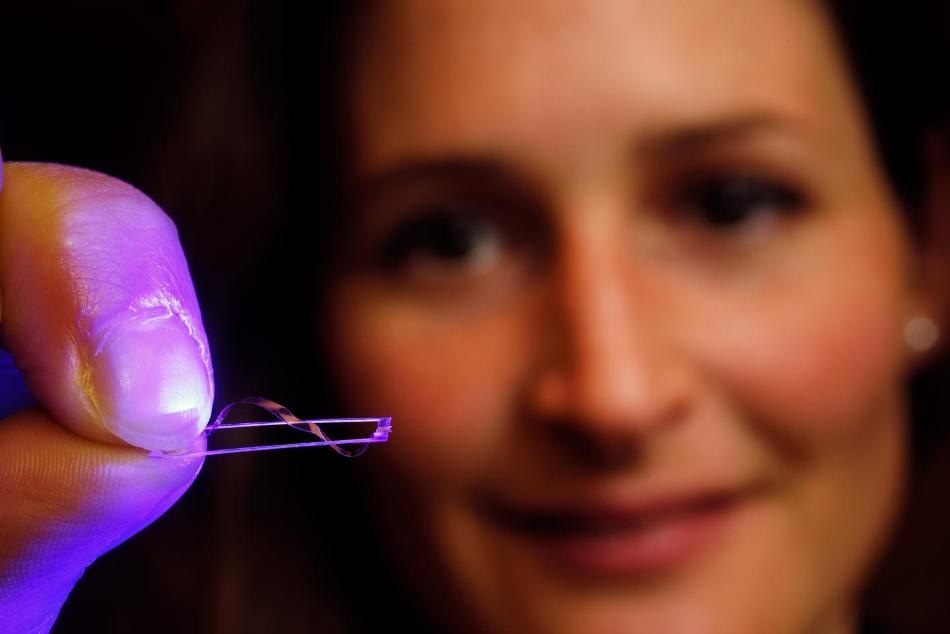Jun 29 2017
A new material capable of undulating and thus propelling itself forward under the influence of light has been developed by Scientists at Eindhoven University of Technology and Kent State University. A strip of this polymer material is clamped in a rectangular frame. It goes for a walk all on its own when illuminated.
This small device that is of the same size like that of a paperclip is considered to be the first machine in the world that will help convert light directly into walking, by just using one fixed light source. The Researchers have published their findings in the recent issue of the scientific journal Nature.
 TU Eindhoven researcher Anne Hélène Gélébart showing the walking device. Photo: Bart van Overbeeke.
TU Eindhoven researcher Anne Hélène Gélébart showing the walking device. Photo: Bart van Overbeeke.
The maximum speed corresponds to that of a caterpillar, about half a centimeter per second. The Researchers assume that it can be employed for transporting tiny items in places that are hard to reach or that it can keep the surface of solar cells clean. The team placed grains of sand on the strip, and the sand was then removed by the undulating movement. The mechanism is extremely powerful such that the strip can also transport an object that is much larger in size and also heavier than the device itself, uphill.
Shadow
The motion of the new material is because of the fact that one side contracts in reaction to light, while the other side expands, and this causes it to bulge when illuminated. Once the light is gone, this deformation instantly disappears. The material completely absorbs the violet light the Researchers used, producing a shadow behind it, even though it appears to be transparent to the human eye.
Undulating movement
The Scientific team, headed by Professor Dick Broer of Eindhoven University of Technology, succeeded in developing a continual undulating movement by using ‘self-shadowing’ effect. The team fixed a strip of the material in a frame shorter than the strip itself, making it bulge. A concentrated LED light was then shone on it, from in front. The part of the strip that receives the light begins to bulge downward, developing a ‘dent’ in the strip. As a result, the next part of the strip appears in front of the light and begins to deform. This results in the ‘dent’ moving backwards, producing a continual undulating movement. This indeed sets the device in motion, walking away from the light. When the device is positioned upside down, the wave passes in the opposite direction, causing it to walk towards the light.
Relaxation
The Researchers managed to reach this particular behavior of the material using ‘liquid crystals’ (familiar in liquid crystal displays; LCDs). The principle depends on the integration of a fast responding light-sensitive variant in a liquid crystalline polymer network. The Researchers developed a material in such a manner that this response is translated to an instantaneous deformation of the strip when illuminated, relaxation directly when the light goes off.
The paper published in Nature is entitled ‘Making waves in a photoactive polymer film (DOI 10.1038/nature22987).’ The Authors include Anne Hélène Gélébart1, Dirk Jan Mulder1, Michael Varga2, Andrew Konya2, Ghislaine Vantomme1, Bert Meijer1, Robin Selinger2 and Dick Broer1 (1: Eindhoven University of Technology, 2: Kent State University). The empirical study was performed in Eindhoven with the corresponding theoretical model being developed in Kent, Ohio. The research was made possible by grants from the Dutch research funding agency NWO and the European Research Council.
World's first directly light driven walking device